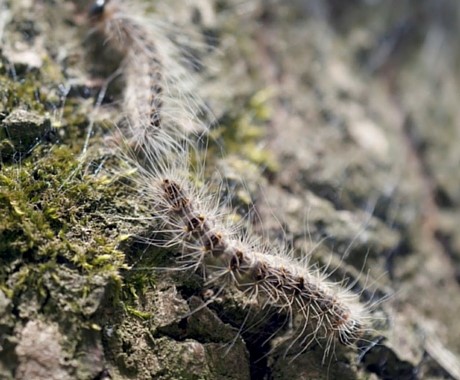The mighty Oak tree is under attack
It’s a sad fact that this most loved of trees, symbolising strength, morale, resistance and knowledge, is being attacked and destroyed by a vicious caterpillar.
These caterpillars are not only a threat to Oak trees, they are a health hazard for humans, pets and wildlife too.
What is Oak Processionary Moth?
The caterpillars, of the Oak Processionary Moth (OPM), emerge mid to late April (or earlier if spring conditions come sooner). They get their name because they can be seen crawling along branches and twigs, nose to tail in a long procession, as they go about stripping the Oak leaves, feeding their way into the pupae stage.
The caterpillars construct silken webbed nests under branches or on the trunk of the tree. These nests can vary in size from a few centimetres to several metres and can be difficult to spot.
The moths emerge from the nests from mid-July to September, living 3 to 4 days, long enough to lay eggs for the cycle to start over again.
Keep your eyes open for OPM
OPM was first recorded in 2006 in the Elmbridge and Spelthorne districts of Surrey.
Guy Barter, Chief Horticulturalist at the RHS, told The Telegraph, “The Processionary Moth is embedded in London now. It only appears on Oak trees and has now spread around west London.”
The Forestry Commission reported in 2018 that the infestation had spread out of London, into the home counties.
We ask that you be vigilant for this pest whilst taking walks in parks and woods. Or if you have Oak trees in your garden, they need checking regularly through the spring and summer months, which we can do for you.
OPM is a health hazard
The fine hairs on the caterpillars can cause itchy rashes on your skin, itchy eyes, breathing problems or sore throats.
Please do not touch the caterpillars or attempt to remove the nests.
What to do if you suspect OPM
Report the sighting immediately to the Forestry Commission or get in touch with us.
Nest removal should only ever be carried out by professional contractors. They need to wear personal protective clothing, have the right equipment and appropriate training to undertake the task, including incineration of the nests at a licensed waste plant.
Unfortunately, OPM is here to stay, so measures need to be put in place to manage this pest for the good of the trees, our personal safety and enjoyment of the environment.
Plant health inspectors will be on site at the Chelsea Flower Show. If any of the exhibitors bring in Oak trees, they will be “destroyed in situ because of a contamination risk”.
If you are concerned about OPM in your garden or near you, please get in touch or call us on 0800 975 4535.


